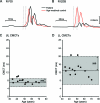Subclinical multisystem neurologic disease in "pure" OPA1 autosomal dominant optic atrophy
- PMID: 21917770
- PMCID: PMC3179647
- DOI: 10.1212/WNL.0b013e318230a15a
Subclinical multisystem neurologic disease in "pure" OPA1 autosomal dominant optic atrophy
Figures

References
-
- Marelli C, Amati-Bonneau P, Reynier P, et al. Heterozygous OPA1 mutations in Behr syndrome. Brain Epub 2011 - PubMed
-
- Horvath R, Hudson G, Ferrari G, et al. Phenotypic spectrum associated with mutations of the mitochondrial polymerase gamma gene. Brain 2006;129:1674–1684 - PubMed
-
- Zeviani M. OPA1 mutations and mitochondrial DNA damage: keeping the magic circle in shape. Brain 2008;131:314–317 - PubMed
Publication types
MeSH terms
Substances
Grants and funding
LinkOut - more resources
Full Text Sources
Medical
